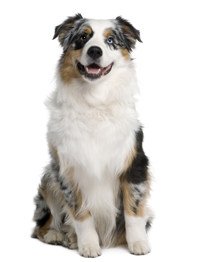To brush your Australian Shepherd’s teeth you will need:
- A pet toothbrush, gauze for wrapping around a finger, or a finger toothbrush.
- Toothpaste designed specifically for dogs.
A finger brush, as the name suggests, simply slides over your finger. If you go with a pet toothbrush, be sure to get one specially designed for an Australian Shepherd or the mouth of a medium breed dog. A small toothbrush designed for a Chihuahua, will do little for your Australian Shepherd. A word of caution: do not use human toothpaste. It can upset your dog’s stomach. Most canine toothpastes are formulated with poultry or malt flavored enhancers for easier acceptance.
As with other aspects of grooming, it is much easier to begin introducing oral hygiene to a puppy, but it is never too late to begin – just start slowly and progress at a pace suitable for your Aussie. Most dogs, be they young or old, will take issue with a toothbrush being jammed in their mouth, so start by using your finger to gently massage his gums. Put a small dab of doggie toothpaste on your index finger, and let your dog lick it. Praise him for being brave! Apply another dab on your finger, gently lift up his outer lips, and massage his gums.
Ideally, it is best to massage in a circular motion but, in the beginning, you may need to be satisfied with simply getting your finger in your dog’s mouth. Try to massage both top and bottom, and the front gums, too. Watch out for those sharp baby teeth, and remember to keep a positive attitude, praising and reassuring your Australian Shepherd throughout the process. It is also helpful if you try to avoid wrestling with your dog or restraining him too tightly. This will only hamper the process and make him resistant to the necessary routine.
Depending on your dog, it may take a few days or a few weeks for him to accept you fiddling about in his mouth. With any luck, he will eventually come to look forward to the routine. That is the long-term goal. It is possible he may never come to enjoy it, but it is important that he learns to accept it.
Once your dog is comfortable with this process, try using a toothbrush, finger toothbrush, or a gauze pad wrapped around your finger. Let your dog lick some toothpaste off the toothbrush or gauze pad and, again, praise him for being brave! This will help accustom him to the texture of the brush or gauze while building his confidence.
You are now ready to begin brushing. As before, lift the outer lips and expose the teeth. Most owners find it easiest to start with the canine teeth – the large ones in the front of the mouth. They are the easiest to reach, and you should be able to brush them with little interference or objection from your dog. Once your dog is accustomed to you brushing a few teeth, progress to a few more, then a few more until you have brushed all 42 teeth (or 28 teeth if you have a puppy).
Chews And Food For Dental Hygiene
You can try using any number of chew or dental toys available for dogs that help to remove plaque. Select products that are right for the chewing style of your Australian Shepherd, and that are made to last. Toys should not replace brushing, but they will help to remove some of the plaque, exercise your Aussie’s jaw, and satisfy his need to chew. Keep an eye on these toys, and toss them when they get too small and become possible choking hazards. Avoid toys and bones that are hard enough to crack or break an aggressive chewer’s teeth.
Many veterinarians recommend avoiding table scraps and sweet treats, because they can increase the buildup of plaque. A high quality crunchy dog food may help to keep plaque from accumulating on teeth; however, this topic is highly debatable among the experts. Either way, a dry, crunchy food is definitely better for exercising your dog’s jaw. Veterinary dentist-approved dog food is available that is designed to help reduce plaque and tartar buildup. Your veterinarian can provide information on these products.

